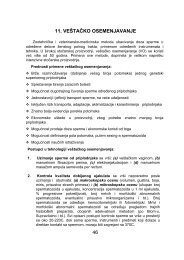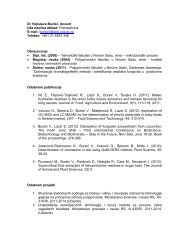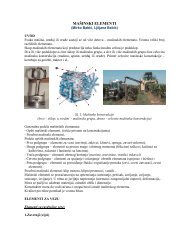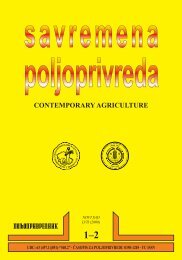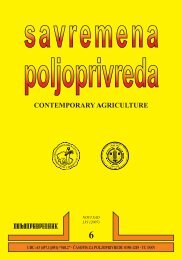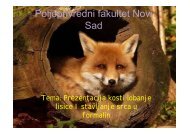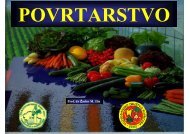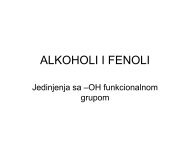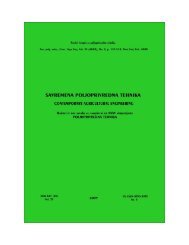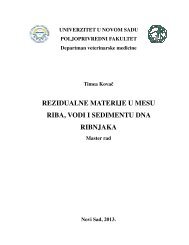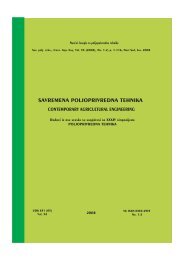LETOPIS naučnih radova - Poljoprivredni fakultet - Univerzitet u ...
LETOPIS naučnih radova - Poljoprivredni fakultet - Univerzitet u ...
LETOPIS naučnih radova - Poljoprivredni fakultet - Univerzitet u ...
You also want an ePaper? Increase the reach of your titles
YUMPU automatically turns print PDFs into web optimized ePapers that Google loves.
4. Togashi K.,Lin C.Y. (2010): Theoretical efficiency of multiple-trait quantitative trait lociassisted<br />
selection, J.Anim.Breed Genet. 127(1), 53-63.<br />
5. Togashi K., Lin C.Y.,Yamazaki T. (2011): The efficiency of genome-wide selection for<br />
genetic improvement of net merit, J.Anim.Sci. 89 (10), 2972-2980.<br />
6. Toosi A., Fernando R.L.,Dekkers J.C.M. (2010): Geneomic selection in admixed and<br />
crossbred populations, J.Anim.Sci. 88, 32-46.<br />
7. Vallet J.L., Freking B.A. Leymaster K.A.,Christenson R.K. (2005): Allelic variation in the<br />
erythropoetin receptor gene is associated with uterine capacity and litter size in swine,<br />
Anim.Genetics, 36, 97-103.<br />
8. Van der Steen H.A.M., Prall G.F.W., Plastow G.S. (2005): Application of genomics to the<br />
pork industry, J.Animal Sci. 83, E1-E8.<br />
9. Van Eenennaam A.L., van der Werf J.H, Goddard M.E. (2011): The value of using DNA<br />
markers for beef bull selection in the seedstock sector, J.Anim.Sci. 89, 307-320.<br />
10. Vidović V., Stupar M. (2010): Molekulska genetika, <strong>Poljoprivredni</strong> <strong>fakultet</strong>, Novi Sad, str.<br />
225.<br />
11. Vidović V., Lukač D. (2010): Genetika životinja, <strong>Poljoprivredni</strong> <strong>fakultet</strong>, Novi Sad, str.361.<br />
12. Vidović V. (2011): Teorija oplemenjivanja životinja, <strong>Poljoprivredni</strong> <strong>fakultet</strong>, Novi Sad, str.<br />
280.<br />
SOME ASPECTS OF IMPLEMENTATION DNA MARKERS IN<br />
ANIMAL BREEDING<br />
Vitomir Vidović, Milanko Stupar, Dragomir Lukač, Ljuba Štrbac<br />
SUMMARY<br />
DNA-based typing will replace blood group and protein marker typing, although<br />
the adoption of a new system will require breeding animals that previously had been<br />
typed to be re-tested using DNA markers. Commonly used types of genetic markers are:<br />
RFLP (restriction fragment length polymorphism), SSLP (simple sequence length<br />
polymorphism), AFLP (amplified fragment length polymorphism), RAPD (random<br />
amplification of polymorphic DNA), VNTR (variable number tandem repeats),<br />
microsatellite polymorphism, SNP (single nucleotide polymorphism), STR (short<br />
tandem repeat), and MS (minisatellites). Aim of this paper is to review some of<br />
available DNA markers in horse, sheep, pig and cattle breeding. The current<br />
commercially available panel comprises 20 microsatellite horse markers: AHT4, AHT5,<br />
ASB2, HMS3, HMS6, HMS7, HTG4, HTG10, VHL20, ASB17, ASB23, LEX33,<br />
LEX3, CA425, HMS1, HMS2, HTG6, HTG7, UM011, AME. In sheep is known 528<br />
markers, in pig 1446 and in cattle 3907 markers. Application of DNA-based methods in<br />
animal breeding programs offer several advantages over conventional parentage assays<br />
in terms of their accuracy and specificity, the ability to use a range of easily obtainable<br />
sample tissues including hair, and laboratory analysis with commonly available<br />
molecular biological reagents.<br />
Key words: DNA markers, animal breeding<br />
Primljeno: 27.08.2012<br />
Prihvaćen: 25.10.2012<br />
108




